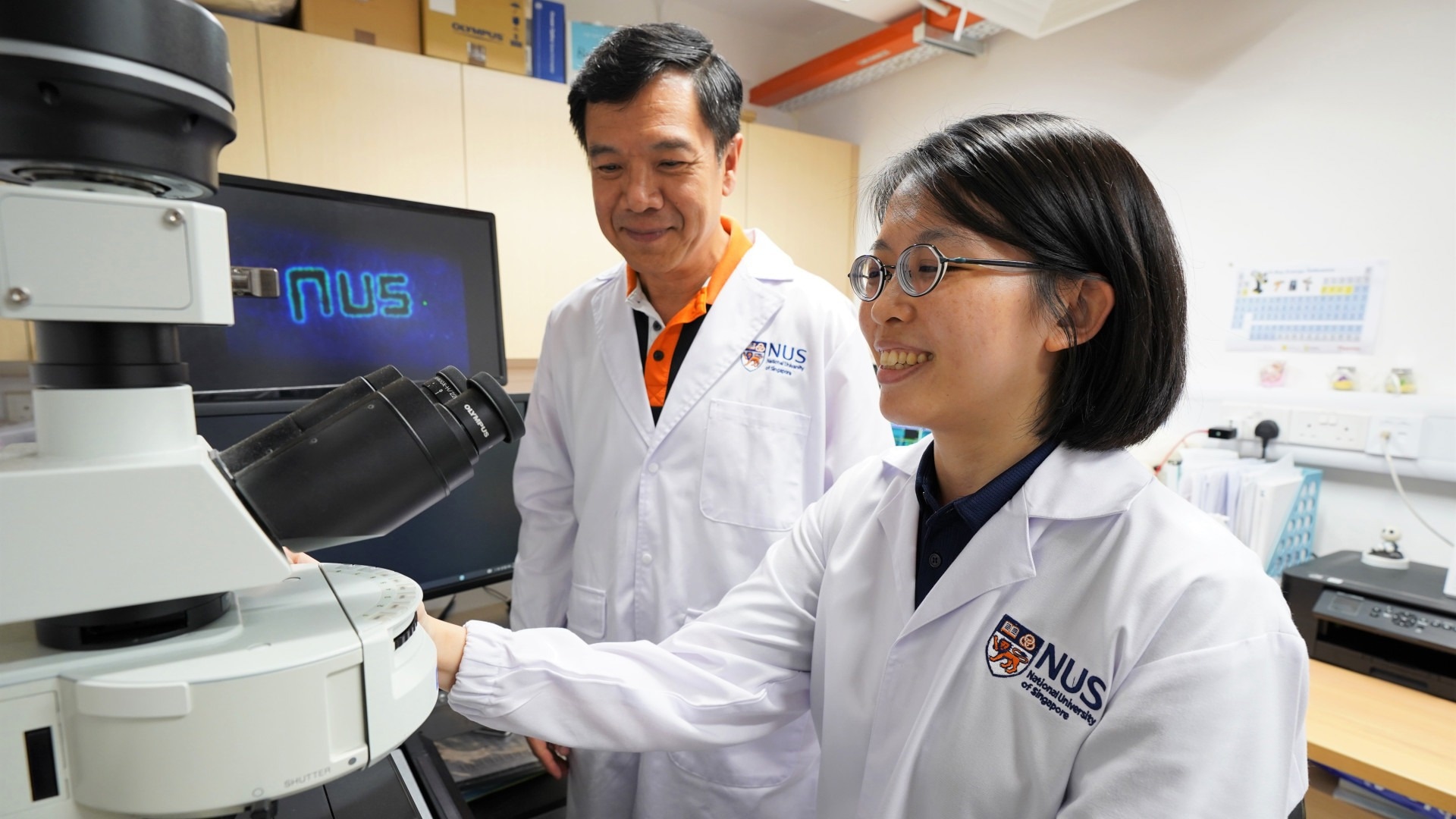National University of Singapore (NUS) physicists have devised a novel process for transforming human hair waste into a useful substance that can be used to encrypt sensitive information or identify environmental pollutants.

Prof Sow Chorng-Haur (left) and Dr. Sharon Lim from the NUS Department of Physics observe a glowing laser-engraved hair under UV light through a microscope. Image Credit: National University of Singapore
A single person can shed 50 to 100 strands of hair every day on average. This generates a significant amount of garbage, which could take years to degrade into its original form or end up in incinerators, waste streams, and dumps, where harmful gases such as ammonia and sulfur dioxide are produced during the decomposition process.
Hair waste landfills can seep hazardous chemicals into bodies of water, endangering marine creatures and potentially causing algal blooms. Furthermore, pathogens can breed in human hair, placing adjacent communities in danger of disease outbreaks.
As the human population increases, there will be increasing pressure to manage human hair waste. Instead of sending hair waste to the incinerator or landfill, it is worthwhile to repurpose hair waste for other potential applications.
Sow Chorng-Haur, Professor, Department of Physics, National University of Singapore
Prof. Sow and his research team, which included Dr. Sharon Lim from NUS, Dr. Zhang Zheng from the Agency of Science, Technology and Research, and Malcolm Sow from the NUS High School of Math and Science, developed a simple, heat-based, chemical-free method to convert human hair waste into a functional material for potential steganographic and pollutant detection applications.
This work was done in keeping with NUS’ commitment to integrated sustainability solutions. In the journal Advanced Photonics Research, which was released with a cover story in late 2022, the team presented a summary of its findings.
Repurposing Hair Waste Using Heat
Human hair has been shown to emit a faint blue fluorescence when exposed to UV radiation. The precise origins or methods underlying this glow are yet unknown, however, it is likely that the chemical composition of the hair plays a part. The researchers tried to turn waste hair into useful material by utilizing the fluorescent properties of human hair.
In their initial experiment, the scientists etched minute designs onto a single strand of black human hair using a concentrated laser beam. The scientists discovered that these patterns lit brightly when exposed to UV using a fluorescence microscope. The laser-engraved patterns glowed about 350% to 400% brighter than the remainder of the strand.
A concentrated laser beam is not necessary for the procedure to be scaled up for industrial use; proven, easily accessible industrial heating technologies can be used to treat more hair at once. The complete hair strands were placed on small ceramic dishes, which were heated for three minutes at 300 °C to 400 °C on top of a hot plate as a proof of concept.
Heat-treated hair shone significantly brighter under a fluorescence microscope than untreated strands, similar to the laser experiment. In particular, hair fluoresced nearly three times as strong as untreated hair when heated to 360 °C.
Sow added, “The discovery of making human hair glow through a simple heating process is a surprise finding in the laboratory. Through thorough investigation, we found that the breaking down of keratin and tryptophan, proteins which form hair, into small chemical by-products during heating was one of the major contributing factors to making the hair glow brighter.”
Concealing Secrets and Catching Chemical Spills
The findings suggest that steganography—the process of hiding hidden information within a regular message or object to prevent detection—can be done with lasers.
The scientists discovered, in particular, that they could adjust their focused laser beam so that it would not physically harm the hair strand while yet being able to successfully etch a fluorescent pattern onto it. The finished product was a seemingly pristine strand that, when exposed to UV light, would reveal its secrets.
The study hypothesized that harmful spills could be found using heat-treated hair on a more macroscopic level. The scientists discovered that white hair showed more fluorescence increase than black hair under the same heating settings.
Fortunately, methylene blue, a dye chemical frequently used in the textile industry and constantly discarded as hazardous waste in bodies of water, is sensitive to white hair. The heat-treated white hair glows strongly under UV light in the presence of methylene blue, making it a potentially low-cost method to identify methylene blue pollution.
Prof. Sow and his team are actively turning human hair waste into a portable methylene blue detector and steganographic ink suited for industrial application.
Sow concluded, “For example, by breaking down heated pristine hair, and suspending them in separate bottles for inkjet printing, hidden messages can readily be printed on different surfaces, thus making this unique waste material an alternative sustainable steganographic material.”
Micro-styling of Biofluorescence in Human Hair as Sustainable and Functional Waste
Video Credit: National University of Singapore